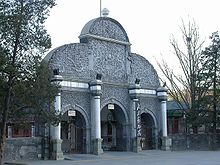Beijing Zoo
The Beijing Zoo ( Simplified Chinese : 北京 动物园; Pinyin: běi jīng dòng wù yuán) in the Chinese capital Beijing was founded in 1906. It was opened to the public on June 18, 1908. With an area of around 90 hectares and between 8 and 12 million visitors per year, it is one of the largest and most important zoos in Asia .
history
When the zoo was founded in 1906, it was initially called "Wan Sheng Yuan", the "Garden of Countless Pets", and at that time covered an area of 3.5 hectares. With the proclamation of the Chinese Republic in January 1912 and the ensuing political unrest, the zoo also had difficulties. These problems were partially resolved in the late 1920s with the creation of the Kuomintang regime under Chiang Kai-shek . When Beijing lost its capital statute in 1928 , the number of animals was drastically reduced.
From 1937 to 1945 Beijing was occupied by the Japanese and suffered from the civil war, later from Guomindang and the communists of Mao Zedong. When Beijing became the capital again in 1949, the zoo counted no more than a blind emu , three parrots and a dozen monkeys.
Since 1958, the area of the site has been steadily increasing, numerous buildings and facilities are being built, and the species population is increasing every year. After the complete renovation on the occasion of the Olympic Games 2008 with many new buildings, e.g. B. For pachyderms 1999, the Beijing Zoo today has about thirty houses, which cover an area of 90 hectares. The aquarium, which is also newly opened, is one of the largest attractions of its kind in the world with around 120,000 m².
Livestock
The current animal population consists of
- 150 species of mammals
- 260 species of birds
- 100 species of reptiles
- 35 amphibian species
- 1000 species of fish and invertebrates
photos
Web links
- Website of the zoo (Chinese)
Coordinates: 39 ° 56 ′ 18.8 ″ N , 116 ° 19 ′ 59.6 ″ E




